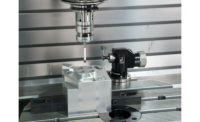Preparing the Next Generation: A Model for Workforce Solutions
The new generation needs to first be made aware of the opportunity in advanced manufacturing.

Summer camps and introductory technology programs are available to even elementary school-age students in the Cazenovia Central School District, and those foundations are built upon once students enter high school. Cazenovia High School’s Riley Lordon and Savannah Johnson are pictured here.
Developed nations, though equipped with industrial and educational infrastructures, face a current and increasing shortage of qualified, skilled and motivated workers.
American manufacturers and smaller operations know this shortage is severe. The skills gap could lead to a shortage of as many as 2.4 million manufacturing workers in the next decade.
The SME Education Foundation has developed and implemented a model to meet workforce development challenges: The SME PRIME (Partnership Response In Manufacturing Education) initiative. SME PRIME is directly enhancing the talent pipeline by partnering with industry to develop manufacturing and engineering programs in high schools across the country.
The SME Education Foundation is a non-profit organization, and the philanthropic arm of SME. It works to advance the next generation of manufacturing and engineering talent. Working closely with SME, academia, and industry, the foundation builds awareness of the career opportunities in the manufacturing industry and provides solutions to develop, build and strengthen the workforce.

Cazenovia High School offers a strong manufacturing training program built upon engineering principles with a mission to inspire young people early in their lives.
A collaborative model, SME PRIME brings together manufacturers and schools to address localized workforce needs and create opportunities for area high school students. The initiative provides modern, advanced manufacturing equipment; a tailored curriculum; and hands-on training experience to students and educators.
These partnerships are critically important because manufacturing is losing large numbers of skilled workers as they retire—and the new generation needs to first be made aware of the opportunity in advanced manufacturing and then educated and developed with the necessary skills, knowledge and abilities needed to succeed.
Anna High School, an SME PRIME School in rural Anna, OH, was highlighted in an extended feature in The New York Times recently, discussing the preparation of high school students for careers in robotics. The story prominently features the school and global manufacturer Honda, the manufacturing partner supporting that school. Through SME PRIME, students are gaining experience with robotics programming and operations, fulfilling manufacturers’ need for people who can operate, troubleshoot, maintain and install robotics and automation technology.

SME PRIME brings together manufacturers and schools to address localized workforce needs and create opportunities for area high school students. Fraser High School is pictured here.
Starkweather Academy, part of Plymouth-Canton Community Schools in Michigan and an SME PRIME school, partnered with a coalition of local manufacturers. One company, LINK Engineering, became involved to sustain its growth, recognizing the critical importance of supporting and training the next generation of craftsman in skilled trade positions such as machinists, electricians, machine builders, fabricators, field service technicians and test technicians.
“The SME PRIME initiative provides a gateway for students to get into the skilled trades and support highly skilled positions at global companies like Link Engineering,” says Jerry Verkerke, LINK Engineering vice president of operations.
Opportunities for all students exist in the new manufacturing environment. The students of Park High School in Racine, WI, another SME PRIME school, acquires knowledge, technical skills and the opportunity to earn credentials while learning in a hands-on environment. Educated as an electrical engineer, Park High School instructor Valerie Webb-Freeman helps young minds first grasp, then embrace, the potential opportunities being offered through technical programs at the school. Those opportunities extend to every educational level.

The students of Park High School in Racine, WI, acquires knowledge, technical skills and the opportunity to earn credentials while learning in a hands-on environment. This is the Park High School Robotic Lab.
“Not every student will, or even should, go to college,” Webb-Freeman says. “It’s ok not to go—but I’m preparing my students to have that choice; to be prepared for a rewarding career or continuing education—or both.” Part of her responsibility, says Webb-Freeman, is informing parents and students of the many paths, opportunities and careers available in manufacturing. “I want to attract everyone; I want to include everyone; to share my own experiences and expose them to an opportunity they may not have known about.”
Cazenovia High School, part of the Cazenovia Central School District in Central New York, a longtime SME PRIME school, offers a strong manufacturing training program built upon engineering principles with a mission to inspire young people early in their lives. Summer camps and introductory technology programs are available to even elementary school-age students in the district, and those foundations are built upon once students enter high school. “My seventh and eighth-grade technology classes taught us the basics of using tools; I really liked making things,” said student Riley Lordon. “And in high school, we’ve expanded that into computer training, design and manufacturing.”

Ford Motor Company Fund and Ford Next Generation Learning partnered to make education opportunities available for students of Romeo High School in Romeo, MI.
Underscoring the value and importance of community support and involvement, The Community Foundation for Southeast Michigan has been instrumental in SME PRIME schools in two Southeast Michigan communities.
Surabhi Pandit is a senior program officer with the Community Foundation and takes pride in the work they do. “We are often the first funder at the table; our grants really help organizations take their work to the next level.” The collaboration with the SME Education Foundation proved to be a very good fit. “We discussed opportunities with the Foundation several times. We’re interested in the ‘why’ and ‘where’; the sustainability of a project or initiative,” Surabhi notes. “The SME PRIME school model made sense to us.”
For a very recent addition to the SME PRIME School network, Ford Motor Company Fund and Ford Next Generation Learning partnered to make education opportunities available for students of Romeo High School in Romeo, MI. The partnership formed at Romeo High School is built on an academy model. Scott Palmer, community coach for Ford NGL at Romeo, describes the initiative: “Ford NGL guides a collaborative network of stakeholders to advance student, community and workforce success following a career academy model,” Palmer said. “Teachers of English, math and science are part of this model, along with technical education. Included is an intentional and structured connection to business and industry.”

Opportunities for all students exist in the new manufacturing environment. Wadsworth High School is shown here.
Tod Rawling, a career and technical education instructor at Romeo High School and veteran of the manufacturing industry, endorses the model. “The academy model really encourages exploration. Students are exposed to courses and experiences that add a hands-on element that helps develop their understanding and appreciation of the opportunities out there.”
I recently told Bloomberg Businessweek that “Manufacturing is not a dark, dull, dying industry. It’s a lucrative industry if you have the right skill set.”
The collaborative, cooperative partnerships forged by the SME Education Foundation through the SME PRIME schools initiative strengthen communities, contribute to the sustainability and growth of manufacturers, and create opportunity for students across the U.S. by building that skill set—and opening doors to fulfilling careers, continued education and unlimited professional achievement.
Looking for a reprint of this article?
From high-res PDFs to custom plaques, order your copy today!





